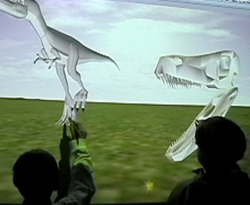Edusim: Difference between revisions
cleanup and copyedit |
→Goals: add reference and expand |
||
| Line 18: | Line 18: | ||
== Goals == |
== Goals == |
||
The goal of the Edusim project is to provide an example platform, and initial resources for demonstrating the use of lesson driven [[Virtual reality|3D virtual environments]] in the classroom or for training purposes using interactive surfaces and/or whiteboards as the hardware platform for the "immersive touch" 3D NUI direct manipulation of the 3D learning content. |
The goal of the Edusim project is to provide an example platform, and initial resources for demonstrating the use of lesson driven [[Virtual reality|3D virtual environments]] in the classroom or for training purposes using interactive surfaces and/or whiteboards as the hardware platform for the "immersive touch" 3D NUI direct manipulation of the 3D learning content. For example, students are able to play with 3D renderings of dinosaur fossils and study the flight of birds from every angle.<ref>{{cite book |title=The Mobile Wave: How Mobile Intelligence Will Change Everything |last=Saylor |first=Michael |year=2012 |publisher=Perseus Books/Vanguard Press |isbn=978-1593157203 |page=177 |pages=304}}</ref> |
||
== History == |
== History == |
||
Revision as of 14:35, 8 June 2012
 | |
| Initial release | Sept. 2007 |
|---|---|
| Written in | Croquet/Cobalt/Squeak |
| Operating system | Mac/Windows/Linux |
| Available in | English |
| Type | Virtual world interactive whiteboard |
| Website | http://edusim3d.com/ |

Edusim is a Cave Automatic Virtual Environment "Immersive Touch" 3D Natural User Interface (NUI) based concept of lesson driven (multi-user) 3D virtual worlds on the classroom interactive whiteboard or classroom interactive surface. The Edusim concept is demonstrated by the Edusim free and open source multi-user 3D Open Cobalt virtual world platform and authoring tool kit modified for the classroom interactive whiteboard or surface. The Edusim application is a modified edition of the open source Open Cobalt Project and relies heavily on the affordances of direct manipulation of 3D virtual learning models and Constructionist Learning Principles.
Goals
The goal of the Edusim project is to provide an example platform, and initial resources for demonstrating the use of lesson driven 3D virtual environments in the classroom or for training purposes using interactive surfaces and/or whiteboards as the hardware platform for the "immersive touch" 3D NUI direct manipulation of the 3D learning content. For example, students are able to play with 3D renderings of dinosaur fossils and study the flight of birds from every angle.[1]
History
The Edusim project originated and the term "immersive touch" 3D natural user interface was coined in September 2007 at the Greenbush Education Service Center in Southeast Kansas as an effort to bring an engaging 3D experience to the classroom interactive whiteboard. Pilot groups were established with 6th and 7th grade middle school students throughout Southeast Kansas to observe how students would engage with the software, and how the user interface would need to be augmented to account for the affordances of the interactive whiteboard, and the usability of the students.
Immersive Touch
Immersive Touch natural user interface is defined as the direct manipulation of 3D virtual environment objects using single or multi-touch surface hardware in multi-user 3D virtual environments. Coined first to describe and define the natural user interface learning principles associated with Edusim. Immersive Touch natural user interface now appears to be taking on a broader focus and meaning with the broader adaption of surface and touch driven hardware such as the IPhone, IPod Touch, IPad, and a growing list of other hardware. Apple also seems to be taking a keen interest in "Immersive Touch" 3D natural user interfaces over the past few years.[citation needed]
Emerging and Potential Immersive Touch Environments
- Edusim-Opensim Opensim virtual worlds on the interactive whiteboard.
- Microsoft Surface combined with 3D virtual learning environment software and learning objectives.
- Dangerous Australians direct manipulation of the virtual learning objects in a collaborative learning environment.
- Smart Table The Smart Table with 3D virtual learning objects & environments.
- PQ Labs ITable The ITable with 3D virtual learning objects and lessons.
- Google Earth on a collaborative interactive surface.
- IPad The IPad.
References
- ^ Saylor, Michael (2012). The Mobile Wave: How Mobile Intelligence Will Change Everything. Perseus Books/Vanguard Press. p. 177. ISBN 978-1593157203.
{{cite book}}: More than one of|pages=and|page=specified (help)
- Edusim functions and functioanlities. Weblog - Greenbush Labs. (11-20-2007).
- Key points to variations of the Edusim IWB environment. Weblog - Greenbush Labs. (2-9-2008).
- Edusim and the Mobile Immersive Learning Lab. Weblog - Greenbush Labs. (2-28-2009).
- Immersive Touch and Edusim. Weblog - Greenbush Labs (8-2-2009)
